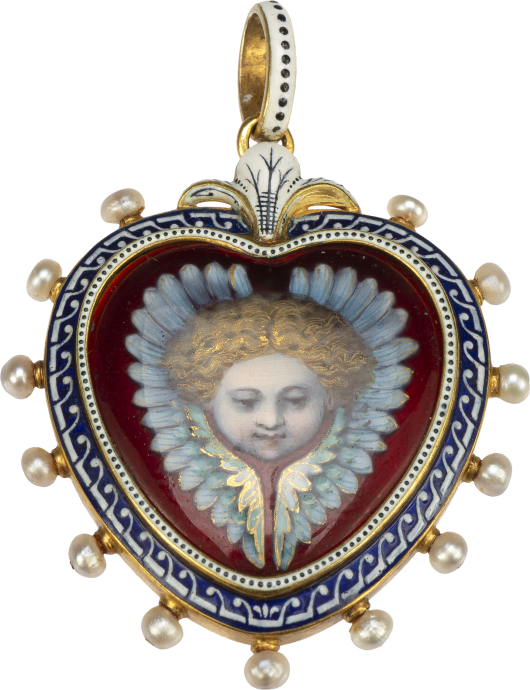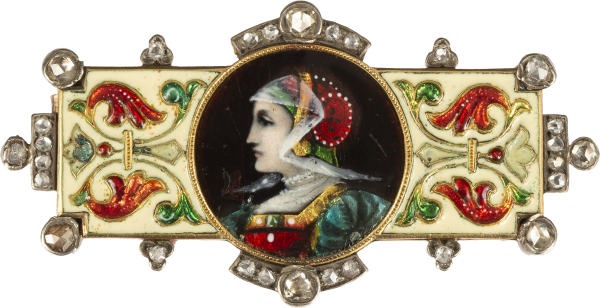


Heart-Shaped Pendant with Cherub
, England (London), c. 1880

Heart-Shaped Pendant with Cherub
Description
Heart-shaped gold pendant with enamel depicts a winged cherub’s head in frontal view against a translucent red background. The hair is golden and the wings pale blue with gilt highlights. The frame has two borders, white with black dots and a meander-like frieze in white on dark blue; thirteen seed pearls on studs adorn the rim. The pendant loop in white with black dots is suspended from a white fleurs-de-lis with foliate ornament in blue. On the reverse is a glass lid (loose in the mount). Below the pendant loop is a plaque with the maker’s mark “CG.”
Of all the Revivalist jewelers, the versatile Carlo Giuliano may be the most difficult to recognize without recourse to his maker’s mark. Self-described as an “art jeweler,” Giuliano probably began his training with Castellani in Rome, which inspired his interest in “archaeological-style” jewels. However, he rapidly developed as an independent artist, employing gemstones in unusual ways, incorporating enamel, using silver and gold, and he was evidently receptive to many different styles – Gothic, Renaissance, even Mughal. This enchanting small-scale, enameled pendant, depicting a cherub in a heart-shaped setting, is a case in point.
Brilliant translucent red enamel sets off the pale blue wings that symmetrically frame the face with downcast eyes of the cherub. Feathery wings and curly hair are skillfully brushed with golden highlights best appreciated under magnification. Whereas enamels by Meyer and Grandhomme imitated subjects of the Renaissance (cat. no. 15), this cherub could never be mistaken for a Renaissance work. Instead, it calls to mind the Pre-Raphaelites, who frequented Giuliano, whose sitters sometimes wore his jewels, and who occasionally supplied designs to the “art jeweler.” The vivid color, lush imagery, and sensuous allure of the Pre-Raphaelites is conveyed in this small jewel. Similar cherubs appear in stained glass by Sir Edward Burne-Jones (1833–1898) and in a drawing by Dante Gabriel Rosetti (d. 1882)
Collaborating with Giuliano, Burne-Jones was especially important as a designer of jewelry; cherubs and hearts, often in the Byzantine style, occur in designs now in the Morgan Library and Museum that he made for jewels. These jewels were often highly personal mementos. With its glass lid on the reverse meant to hold a keepsake, the present heart-shaped pendant was perhaps intended as a gift for a member of the Pre-Raphaelite circle.
Literature:
compare for similar opaque white enamels with fine blue or black markings, Phillips 2019, p. 96 (pendant in the Victoria and Albert Museum); Falk 2004, p. 53, fig. 54, and Gere/Munn 1989, pp. 68–69 (a pendant and necklace respectively); Munn 1975, p. 162, pls. 8a/b (a pendant and earrings with cherubs by Giuliano); for Burne-Jones drawings and Giuliano, Gere/Munn, pp. 139–141.
